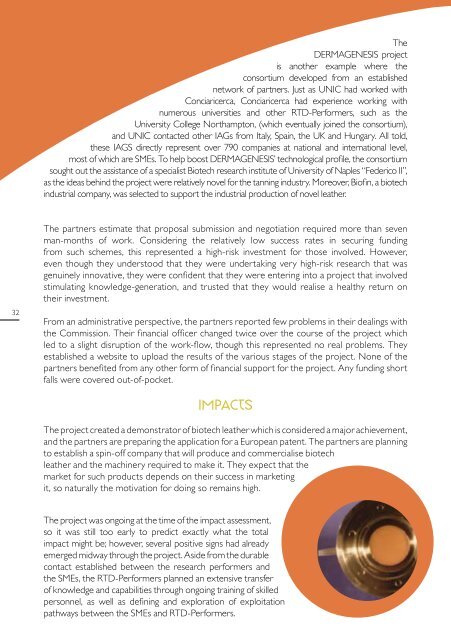SMEs and Research - European Commission - Europa
SMEs and Research - European Commission - Europa
SMEs and Research - European Commission - Europa
Create successful ePaper yourself
Turn your PDF publications into a flip-book with our unique Google optimized e-Paper software.
32<br />
The<br />
DERMAGENESIS project<br />
is another example where the<br />
consortium developed from an established<br />
network of partners. Just as UNIC had worked with<br />
Conciaricerca, Conciaricerca had experience working with<br />
numerous universities <strong>and</strong> other RTD-Performers, such as the<br />
University College Northampton, (which eventually joined the consortium),<br />
<strong>and</strong> UNIC contacted other IAGs from Italy, Spain, the UK <strong>and</strong> Hungary. All told,<br />
these IAGS directly represent over 790 companies at national <strong>and</strong> international level,<br />
most of which are <strong>SMEs</strong>. To help boost DERMAGENESIS’ technological profile, the consortium<br />
sought out the assistance of a specialist Biotech research institute of University of Naples “Federico II”,<br />
as the ideas behind the project were relatively novel for the tanning industry. Moreover, Biofin, a biotech<br />
industrial company, was selected to support the industrial production of novel leather.<br />
The partners estimate that proposal submission <strong>and</strong> negotiation required more than seven<br />
man-months of work. Considering the relatively low success rates in securing funding<br />
from such schemes, this represented a high-risk investment for those involved. However,<br />
even though they understood that they were undertaking very high-risk research that was<br />
genuinely innovative, they were confident that they were entering into a project that involved<br />
stimulating knowledge-generation, <strong>and</strong> trusted that they would realise a healthy return on<br />
their investment.<br />
From an administrative perspective, the partners reported few problems in their dealings with<br />
the <strong>Commission</strong>. Their financial officer changed twice over the course of the project which<br />
led to a slight disruption of the work-flow, though this represented no real problems. They<br />
established a website to upload the results of the various stages of the project. None of the<br />
partners benefited from any other form of financial support for the project. Any funding short<br />
falls were covered out-of-pocket.<br />
IMPACTS<br />
The project created a demonstrator of biotech leather which is considered a major achievement,<br />
<strong>and</strong> the partners are preparing the application for a <strong>European</strong> patent. The partners are planning<br />
to establish a spin-off company that will produce <strong>and</strong> commercialise biotech<br />
leather <strong>and</strong> the machinery required to make it. They expect that the<br />
market for such products depends on their success in marketing<br />
it, so naturally the motivation for doing so remains high.<br />
The project was ongoing at the time of the impact assessment,<br />
so it was still too early to predict exactly what the total<br />
impact might be; however, several positive signs had already<br />
emerged midway through the project. Aside from the durable<br />
contact established between the research performers <strong>and</strong><br />
the <strong>SMEs</strong>, the RTD-Performers planned an extensive transfer<br />
of knowledge <strong>and</strong> capabilities through ongoing training of skilled<br />
personnel, as well as defining <strong>and</strong> exploration of exploitation<br />
pathways between the <strong>SMEs</strong> <strong>and</strong> RTD-Performers.
















